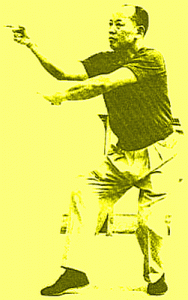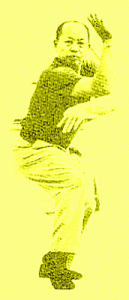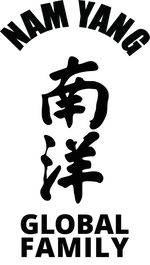An article originally published in Bushido Magazine in 1974. Be warned – this is not very accurate.
GrandMaster Ang Liang Huat – Fukien Tiger Crane Boxing
October 23, 2007
An insight of Shaolin fighting systems, including Hor Hok Siang Heng – Tiger Crane Combination.
(Extracted from article originally published in “Bushido” Singapore)


In the rugged terrains of Fukien Province, in the Tian Hor area of Eng Chun (Yong Chun) District, there existed a Buddhist temple known as Pak Lok Shiang Shan. It was in the year of Tai Hoe that an old Shaolin monk came to this temple. It was said that this high ranking monk from Shaolin Temple was specially invited by the monks of Pak Lok. The Shaolin Temple from which he came from was not the one where Bodhidarma resided, which was situated in Honan Province. It was the Shaolin Temple in Fukien which was constructed in his honor by some of his famed disciples.
According to legend, the monk was known as Tze Chien. He was trained in both the system of ‘Tak Choon’ 5 sets – the direct legacy of Bodhidarma and the crane system – the legacy of the monk Pak Hok.
On arrival at the Pak Lok Temple, he started teaching Kung Fu.
Years passed and Shaolin Kung fu infiltrated into almost all the villages of the Eng Chun District. The villages took up martial art training with the motive of repelling bandit attacks. Governmental forces were either too weak or took too long to come to the aid of remote villages.
The spreading of Shaolin Kung Fu was mostly done by boxers who had been trained by the monks. Some were engaged on a full-time basis by certain villages. These masters were held in high esteem because they had the force to counter evil. But then, they also had the force to commit evil. It was therefore quite difficult for the masters to decide whom to teach. They came up with ploy of testing their disciples’ patience. Aspirants had to do manual chores for them for many years before they were even taught the basics.
Hardship drove many of the people of Eng Chun District to turn towards the sea for a living. Like most of the Chinese living along the coastal provinces, they became fisherman or worked on trading junks. There voyages took them to all parts of South East Asia.
Many of them migrated and settled overseas, especially in Nanyang, which is now the region composing of Malaysia and Singapore. Their objective was to make enough and return to China and easy life.
The parents of Ang Liang Huat were no different. They migrated and settled in Singapore. By the time he was eight, they had enough money to return to their homeland. With the money they had saved they bought land to cultivate. Being the son of a landlord, Ang had no necessity to work. All his time were taken with the pursuit of his interest; Kung Fu.
He learned the secrets of Shaolin boxing from the age of ten until he was twenty two. By then, with looming war clouds, the country was in turmoil. The Ang family left for Singapore, this time never to return.
Liang Huat had learned enough Kung Fu systems to last him a lifetime. He had numerous teachers as his parent could afford to pay for the best.
His teachers:-
Tek Hong Yew, alias ‘Sim Pik Lao Lang’ or the ‘The mysterious old man, was Ang’s first sifu. He had the habit of coming and mysteriously leaving without a word and hence the nickname. Hong Yew was the nephew of the renown Tek Lah, the 3rd placed contestant in all-China ‘Stance Contest’ at Peking, at which Generalissimo Chang Kai Shek was also a spectator. It was reputed that not even the combined efforts of several men could budge him an inch when he assumed his stance.
Ang’s second teacher was the monk Shiang Lim. He was from the Chun Chien Shaolin Temple.
His third, Tan Kwee Long, taught him the use of weapons. Tan was a Tai Chor master and acknowledged leader of all the peddlers of herbal medicines in the Eng Chun District.
The stout and tough looking Ang is fifty, but his looks belie his years. To Bushido’s query of “What is Ngo Chor Kung Fu?” Ang replied that it was the term given to the Shaolin art and the combination of the following five famous styles.
- Tak Choon Koon – directly taught by Bodhidarma
- Tai Chor Koon – propagated by the Emperor Sung Tai Chor
- Kow Koon – The Monkey Art, taught by the monk Heng Chai
- Pek Hok Koon – The Crane System, taught by the monk Pak Hor
- Lohan Koon – evolved by the monks of Shaolin
To a further query of “What happened to the Nun’s Fighting Art taught by the Ngo Mei?” Ang said that it was part of Peh Hok Koon, just like Wing Chun is part of the Ngo Mei system.
Ang said that there were many who claimed to be masters of Ngo Chor Koon. He was skeptical of their claims as these five styles would take a man more than a lifetime to master, each taking more than thirty years to complete. It was humanly impossible for any one to master all the give systems. He explained that the present style he is teaching is the Tiger-Crane combination.
“Never consider your techniques or style as the ultimate in marital arts, nor your counter as the only counter. Remember that there is always a counter against another counter,” Ang advised.
“What is Tak Choon Koon?” Bushido ventured.
“It is composed of five sets of movements designed to exercise the body and strengthen the internal. The hands and legs are spread out in the movements and tremendous strength exerted. It also involves breathing and meditation. It was later modified into Sam Chien Koon, a cousin of Sanchin in Karate. This was also known as ‘Tiong Chi Koon’, literally meaning Middle Arrow Style.”
According to Ang, Tai Chor techniques only involved forearm movements at its inception. The arms were kept very close to the chest. This was a defensive art and it was difficult for an attacker to penetrate the defense of such a stylist. It had its restriction in that it was also difficult for the practitioner to attack freely, having only the use of two jointed parts – the fist and forearm.
This was later modified, using ‘Sam Chat’ or three jointed parts; namely the fist, forearm and arm. The modified techniques enabled practitioners to attack more freely and have a longer reach.
Tai Chor is based on strong, powerful movements and accompanied by loud shouting at every move. Altogether, it is a fearsome style, based on the behavior and movements of an attacking tiger.
The Monkey style has many versions. Different systems like Tai Chor and White Crane have adapted and incorporated it into their art, presenting it in a slightly different form.
“I practiced the Full Monkey forms,” Ang said. “It was the most popular style in Eng Chun District. The difference is that in the Full Monkey forms, only tip of the toes touch the ground when one is in a stance. This provides the practitioner with a great mobility. For attack the following techniques are used: Piercing fingers, back hand strike, elbow strike, turning kicks, frontal flicking kicks, grabbing, rolling and sweeping.
The White Crane style was based on the long-limbed movements of the bird from which the name was derived. Names of certain elements were used for hand techniques. Kin (Gold) was the name given to the side block, Bok (Wood) to the down block, Chwee (Water) to the twirling block, Hay (Fire) to the upward block, and Thor (Earth) to the elbow block.
Ang was requested by Bushido to elaborate on the kicks used by the Tiger-Crane combination. The following are supplied by him:
- Spearing kick to the face
- Scissor kick – sweeping to throw opponents off balance
- Golden Sleepers – Twin maneuvers, one leg stamping and the other executing a high kick
- Kim Yam – turning double kicks for surprise attack
- Golden Swallow Yin Yang Kick – double kicks, the first as a feint
- Peh Beh (White Horse Kick) – used when one leg is caught by an opponent. Executed by dropping to the ground, supported by the hands and using a back kick with the free leg.
- Sweeping ‘Sha Tong’ Kick – low double sweeping kicks to topple the opponent
These formed only part of the comprehensive array of kicking techniques of Ang. Some were akin to TKD techniques and those of northern Chinese boxing.
Sifu Ang assisted Quek Yong Haw, the Tai Chor master, at the Mun Nam Pugilistic Association from 1951 before he started his own club, the Nanyang Pugilistic Association in 1953.
